Published
on 29
May 2015
|
All rights reserved.
|
|
|
Flyweight roadsters
are unique to Japan. Their manufacturers use components from mass
production Kei-cars to realize the smallest sports cars ever seen in
the world. They might not be sold in large numbers, but they always
ignite the excitement of young car lovers and the interest of the
press. In recent memory, Suzuki Cappucino and Honda Beat were most
talked about. Even though they ceased production for nearly 2 decades
people still recall them as some of the most interesting roadsters ever
seen. Closely followed them was the original Daihatsu Copen. Born in
2002, it was cute, tiny, cheap yet unusually featured a retractable
metal roof. It was probably this roof kept it in production for
10 long years. Since the demise of Copen, Japan ran into a brief period
without any K-car roadsters. Fortunately, last year 2 new models were
announced: Honda S660 and the second generation Copen. Young Japanese
motorists have something to cheer about again.
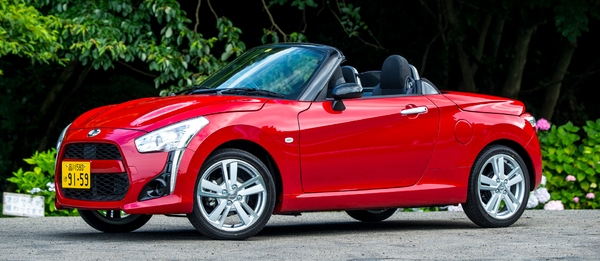
|
Although the original Copen was most recognized for a Beetle-like
shape, its maker believes the second generation should seek a new
styling direction in order to attract new interests. Unlike the radical
approach of Honda, which designed a bespoke mid-engined chassis for its
S660, Daihatsu opted for reusing as many components from its Kei-car
parts bin as possible. This means a compulsory FF layout. However, by
lengthening the front overhang it is capable to realize a long-bonnet
proportion that looks much like a conventional FR roadster. The overall
length and width are dictated by government regulations. The wheelbase
is set at 2230 mm, same as the last Copen. The roadster is much lower
than a normal K-car, of course, but not as low as Honda. As for
detailed design, the design team came up with 2 polarizing options,
i.e. a
rounder, more civilized design called “Robe”, which should appeal to
ladies, and a tougher, crossover-style design called “Xplay”. Which one
is better? Difficult question. Why not have both?
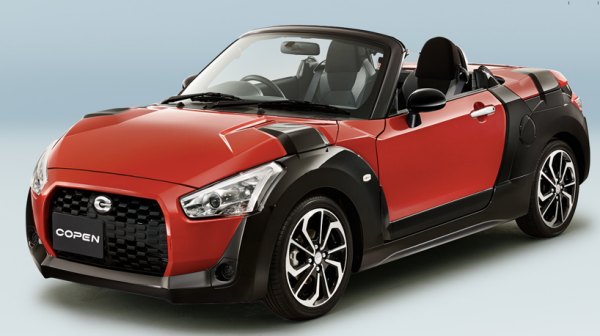
|
To that end, Daihatsu designed a steel skeleton chassis called
“D-frame” and dressed it with body panels made of resin (only the door
shells are steel and fixed to the frame). Theoretically, by replacing
these resin panels the exterior can switch between Robe and Xplay,
although such work has to be done in selected service centers. The
concept is not unlike the original Smart city car, whose plastic skins
could be changed to different colors or patterns. In reality, I suppose
few customers would spend money on the change of clothes. However, this
approach does help the Copen to broaden its customer base without
investing into costly steel stamping and assembly machines. It also
makes possible for more derivatives or facelifts to come in the future,
keeping the car fresh to eyes and hopefully in production for another
10 years.
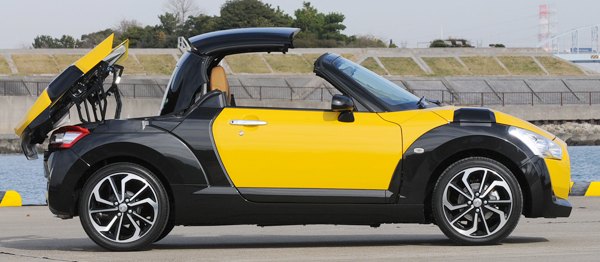
|
The
chassis frame itself is adequately strengthened to compensate the open
roof. It has a stronger backbone, sills, A-pillars and underfloor
cross-members. Tubular roll bars are fixed behind the seats to protect
the occupants. The 2-piece retractable roof, now made of resin as well,
has a moving mechanism carried over from the old car. No complaint
here, as it opens or closes smoothly in 20 seconds. When it is up, the
boot can swallow respectable amount of luggage. Even when it is stored,
the luggage space left underneath the roof panels is still a lot more
than the front boot of Honda S660. The Copen is clearly the more
practical car to use on daily basis.
The cabin is not as stylish as Honda, even though it is improved from
the usual standards of Daihatsu. While the instrument is clear, the
center console is a bit toy-like, and the optional sat-nav screen
stands strangely above the dashboard as it if added as an
afterthought. All plastics are hard ones, although they are grained to
feel more substantial than the usual K-cars. Cabin space is actually
pretty generous considering its size. Moreover, outward visibility is
definitely better than Honda. With the roof down, it feels airy.
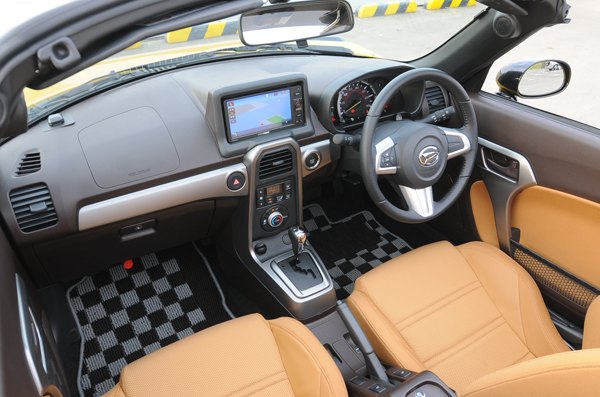
|
Like Honda, the Daihatsu roadster offers 1 engine and 2 transmissions.
The 660 c.c. 3-cylinder turbo is said to be equipped with DVVT, but the
D here probably refers to Daihatsu or Dynamic, as the variable valve
timing works on the intake camshaft only. This engine is carried over
from other K-cars of the group without alteration, so it produces the
same 64 ps at 6400 rpm and 68 lbft of torque at 3200 rpm. The torque
delivery is a little weaker and peakier than Honda S660, which offers
77 lbft at 2600 rpm. On the road, it also feels less energetic at lower
revs. The turbo spools up at about 2500 rpm and feels strongest from
3800 rpm upward. The performance it delivers is adequate on Japanese
soil, but if it was exported to Australia or the Western world, I’m
afraid it could not satisfy their motorists. Expect 0-60 mph to take
around 12 seconds, no faster than a 50-years-old MGB.
Daihatsu’s 5-speed manual does not match Honda’s 6-speeder for
gearshift quality as well as close-ratio fun, but it is still worth
more recommendation than the alternative CVT.
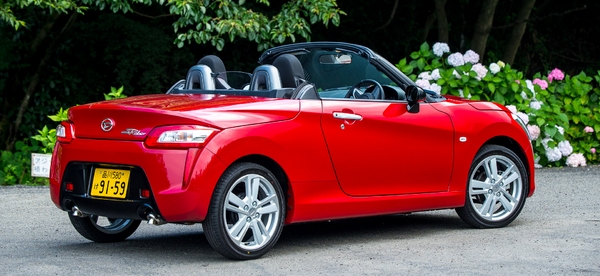
|
In terms of handling, the front-wheel-drive Copen is not supposed to be
as sporty as the mid-engined S660 for sure. Basically, it is a K-car
happens in the form of roadster rather than a bespoke sports car
happens in the K-car category. It is a delight to drive in urban area,
thanks to its small size and short turning radius. On open roads, it
corners with respectable stability and composure, but you are aware the
higher center of gravity from its body roll and the less grip it
generates compared with the Honda. Its electric steering is light at
low speed and weighs up nicely at speed, but the nose does not turn in
as keenly as the Honda. However, its chassis is more interactive with
the driver. Push it too fast into corner will induce understeer. Lift
off
mid-corner will tighten its line, something the grippy Honda refuses to
do. While S660 cries for more power to exploit its capable chassis, the
Copen has its chassis well matched with its power.
That is enough to warrant a win. The Copen is 10 percent cheaper than
the S660, but it offers an excellent retractable roof as standard and,
in my eyes, funkier looks. Limited by the regulated dimensions and
engine restrictions, K-car roadsters will never match a proper roadster
like Mazda MX-5 for performance and driver entertainment. Daihatsu is
clever not to take the sporty route and concentrate on what K-car does
best. It is cute, affordable and practical, just like its predecessor.
|
Verdict:     |
|